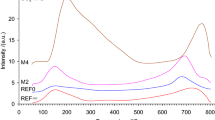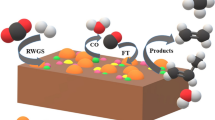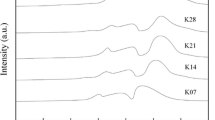Abstract
FeCx catalysts (Fe-CN-Py) were synthesized by co-pyrolyzing the mixture of iron nitrate and a CN source (melamine, bulk g-C3N4 (b-C3N4), or defective g-C3N4 (d-C3N4)). The physicochemical properties of Fe-CN-Py catalysts and their activities of CO2 hydrogenation to light hydrocarbon (C2-C6) were analyzed. The results indicated that Fe-d-C3N4-(0.3)-Py is the most promising with the highest CO2 conversion (47.2%), olefin yield (10.8%), and olefin space-time yield (STY = 4.5 µmol olefin/s/gFe). The promising activity of Fe-d-C3N4-(0.3)-Py was attributed to its high concentration of surface FeCx. The correlation between surface FeCx and the STY of hydrocarbons and olefins was established.







Similar content being viewed by others
References
Eskander SMSU, Fankhauser S (2020) Reduction in greenhouse gas emissions from national climate legislation. Nat Clim Change 10(8):750–756. https://doi.org/10.1038/s41558-020-0831-z
Yang Z, Qi Y, Wang F, Han Z, Jiang Y, Han H, Liu J, Zhang X, Ong WJ (2020) State-of-the-art advancements in photo-assisted CO2 hydrogenation: recent progress in catalyst development and reaction mechanisms. J Mater Chem A 8(47):24868–24894. https://doi.org/10.1039/D0TA08781E
Albero J, Peng Y, García H (2020) Photocatalytic CO2 reduction to C2+ products. ACS Catal 10(10):5734–5749. https://doi.org/10.1021/acscatal.0c00478
Hasan MMF, Rossi LM, Debecker DP, Leonard KC, Li Z, Makhubela BCE, Zhao C, Kleij A (2021) Can CO2 and renewable carbon be primary resources for sustainable fuels and chemicals? ACS Sustain Chem Eng 9(37):12427–12430. https://doi.org/10.1021/acssuschemeng.1c06008
Alkhatib II, Garlisi C, Pagliaro M, Al-Ali K, Palmisano G (2020) Metal-organic frameworks for photocatalytic CO2 reduction under visible radiation: a review of strategies and applications. Catal Today 340:209–224. https://doi.org/10.1016/j.cattod.2018.09.032
Tackett BM, Gomez E, Chen JG (2019) Net reduction of CO2 via its thermocatalytic and electrocatalytic transformation reactions in standard and hybrid processes. Nat Catal 2(5):381–386. https://doi.org/10.1038/s41929-019-0266-y
Jiang X, Nie X, Guo X, Song C, Chen JG (2020) Recent advances in carbon dioxide hydrogenation to methanol via heterogeneous catalysis. Chem Rev 120(15):7984–8034. https://doi.org/10.1021/acs.chemrev.9b00723
Kondratenko EV, Mul G, Baltrusaitis J, Larrazábal GO, Pérez-Ramírez J (2013) Status and perspectives of CO2 conversion into fuels and chemicals by catalytic, photocatalytic and electrocatalytic processes. Energy Environ Sci 6(11):3112–3135. https://doi.org/10.1039/C3EE41272E
Niu J, Liu H, Jin Y, Fan B, Qi W, Ran J (2022) Comprehensive review of Cu-based CO2 hydrogenation to CH3OH: insights from experimental work and theoretical analysis. Int J Hydrogen Energy 47(15):9183–9200. https://doi.org/10.1016/j.ijhydene.2022.01.021
Ding Z, Xu Y, Yang Q, Hou R (2022) Pd-modified CuO–ZnO–ZrO2 catalysts for CH3OH synthesis from CO2 hydrogenation. Int J Hydrogen Energy 47(59):24750–24760. https://doi.org/10.1016/j.ijhydene.2022.05.226
Li W, Wang H, Jiang X, Zhu J, Liu Z, Guo X, Song C (2018) A short review of recent advances in CO2 hydrogenation to hydrocarbons over heterogeneous catalysts. RSC Adv 8(14):7651–7669. https://doi.org/10.1039/c7ra13546g
Sharma P, Sebastian J, Ghosh S, Creaser D, Olsson L (2021) Recent advances in hydrogenation of CO2 into hydrocarbons via methanol intermediate over heterogeneous catalysts. Catal Sci Technol 11(5):1665–1697. https://doi.org/10.1039/D0CY01913E
Ronda-Lloret M, Rothenberg G, Shiju NR (2019) A critical look at direct catalytic hydrogenation of carbon dioxide to olefins. Chemsuschem 12(17):3896–3914. https://doi.org/10.1002/cssc.201900915
Ye RP, Ding J, Gong W, Argyle MD, Zhong Q, Wang Y, Russell CK, Xu Z, Russell AG, Li Q, Fan M, Yao YG (2019) CO2 hydrogenation to high-value products via heterogeneous catalysis. Nat Commun 10(1):5698. https://doi.org/10.1038/s41467-019-13638-9
Zhang Z, Yin H, Yu G, He S, Kang J, Liu Z, Cheng K, Zhang Q, Wang Y (2021) Selective hydrogenation of CO2 and CO into olefins over sodium- and zinc-promoted iron carbide catalysts. J Catal 395:350–361. https://doi.org/10.1016/j.jcat.2021.01.036
Peña D, Jensen L, Cognigni A, Myrstad R, Neumayer T, van Beek W, Rønning M (2018) The effect of copper loading on iron carbide formation and surface species in iron-based Fischer–Tropsch synthesis catalysts. ChemCatChem 10(6):1300–1312. https://doi.org/10.1002/cctc.201701673
Numpilai T, Chanlek N, Poo-Arporn Y, Cheng CK, Siri-Nguan N, Sornchamni T, Chareonpanich M, Kongkachuichay P, Yigit N, Rupprechter G, Limtrakul J, Witoon T (2020) Tuning interactions of surface-adsorbed species over Fe – Co/K – Al2O3 catalyst by different K contents: selective CO2 hydrogenation to light olefins. ChemCatChem 12(12):3306–3320. https://doi.org/10.1002/cctc.202000347
Witoon T, Numpilai T, Nueangnoraj K, Cheng CK, Chareonpanich M, Limtrakul J (2021) Light olefins synthesis from CO2 hydrogenation over mixed Fe–Co–K supported on micro-mesoporous carbon catalysts. Int J Hydrogen Energy. https://doi.org/10.1016/j.ijhydene.2021.10.265
Taghavi S, Asghari A, Tavasoli A (2017) Enhancement of performance and stability of graphene nano sheets supported cobalt catalyst in Fischer–Tropsch synthesis using graphene functionalization. Chem Eng Res Des 119:198–208. https://doi.org/10.1016/j.cherd.2017.01.021
Najari S, Gróf G, Saeidi S (2019) Enhancement of hydrogenation of CO2 to hydrocarbons via in-situ water removal. Int J Hydrogen Energy 44(45):24759–24781. https://doi.org/10.1016/j.ijhydene.2019.07.159
Wang J, Wang S (2022) A critical review on graphitic carbon nitride (g-C3N4)-based materials: Preparation, modification and environmental application. Coord Chem Rev 453:214338. https://doi.org/10.1016/j.ccr.2021.214338
Zhang J, Yang B, Luo KH (2022) Unveiling the mechanism of controllable CO2 hydrogenation by group VIB metal single atom anchored on N-doped graphite: a density functional theory study. Int J Hydrogen Energy 47(97):40972–40985. https://doi.org/10.1016/j.ijhydene.2022.09.170
Park H, Youn DH, Kim JY, Kim WY, Choi YH, Lee YH, Choi SH, Lee JS (2015) Selective formation of Hägg iron carbide with g-C3N4 as a sacrificial support for highly active Fischer–Tropsch synthesis. ChemCatChem 7(21):3488–3494. https://doi.org/10.1002/cctc.201500794
Eissa AA, Peera SG, Kim NH, Lee JH (2019) g-C3N4 templated synthesis of the Fe3C@NSC electrocatalyst enriched with Fe–Nx active sites for efficient oxygen reduction reaction. J Mater Chem A 7(28):16920–16936. https://doi.org/10.1039/C9TA01837A
Zhang B, Chen J, Guo H, Le M, Guo H, Li Z, Wang L (2021) Iron carbide nanoparticles supported by nitrogen-doped carbon nanosheets for oxygen reduction. ACS Appl Nano Mater 4(8):8360–8367. https://doi.org/10.1021/acsanm.1c01542
Shen Y (2015) Carbothermal synthesis of metal-functionalized nanostructures for energy and environmental applications. J Mater Chem A 3(25):13114–13188. https://doi.org/10.1039/C5TA01228G
Trangwachirachai K, Chen C-H, Huang A-L, Lee J-F, Chen C-L, Lin Y-C (2022) Conversion of methane to acetonitrile over GaN catalysts derived from gallium nitrate hydrate co-pyrolyzed with melamine, melem, or g-C3N4: the influence of nitrogen precursors. Catal Sci Technol 12(1):320–331. https://doi.org/10.1039/D1CY01362A
Lin Y-C, Hsieh C-H (2022) Cobalt catalysts derived from layered double hydroxide/g-C3N4 composite in the hydrogenation of γ-valerolactone into 1,4-pentanediol. Catal Surv Asia. https://doi.org/10.1007/s10563-022-09383-7
Gao J, Wang Y, Zhou S, Lin W, Kong Y (2017) A facile one-step synthesis of Fe-doped g-C3N4 nanosheets and their improved visible-light photocatalytic performance. ChemCatChem 9(9):1708–1715. https://doi.org/10.1002/cctc.201700492
Wang C, Kang J, Liang P, Zhang H, Sun H, Tadé MO, Wang S (2017) Ferric carbide nanocrystals encapsulated in nitrogen-doped carbon nanotubes as an outstanding environmental catalyst. Environ Sci Nano 4(1):170–179. https://doi.org/10.1039/C6EN00397D
Ghosh S, Ramaprabhu S (2019) Green synthesis of transition metal nanocrystals encapsulated into nitrogen-doped carbon nanotubes for efficient carbon dioxide capture. Carbon 141:692–703. https://doi.org/10.1016/j.carbon.2018.09.083
Ravel B, Newville M (2005) ATHENA, ARTEMIS, HEPHAESTUS: data analysis for X-ray absorption spectroscopy using IFEFFIT. J Synchrotron Radiat 12(4):537–541. https://doi.org/10.1107/S0909049505012719
Witoon T, Chaipraditgul N, Numpilai T, Lapkeatseree V, Ayodele BV, Cheng CK, Siri-Nguan N, Sornchamni T, Limtrakul J (2021) Highly active Fe-Co-Zn/K-Al2O3 catalysts for CO2 hydrogenation to light olefins. Chem Eng Sci 233:116428. https://doi.org/10.1016/j.ces.2020.116428
Chen B-Y, Dobele G, Plavniece A, Volperts A, Tamasauskaite-Tamasiunaite L, Norkus E, Chen C-L, Lin Y-C (2023) Catalytic hydrogenation of CO2 to light olefins by using K-doped FeCx catalysts derived from the Fe-chitosan complex. Int J Hydrogen Energy 48:4276–4286. https://doi.org/10.1016/j.ijhydene.2022.11.010
Li X, Zhang J, Shen L, Ma Y, Lei W, Cui Q, Zou G (2009) Preparation and characterization of graphitic carbon nitride through pyrolysis of melamine. Appl Phys A 94(2):387–392. https://doi.org/10.1007/s00339-008-4816-4
Titantah JT, Lamoen D (2007) Carbon and nitrogen 1s energy levels in amorphous carbon nitride systems: XPS interpretation using first-principles. Diam Relat Mater 16(3):581–588. https://doi.org/10.1016/j.diamond.2006.11.048
Wieczorek-Ciurowa K, Kozak AJ (1999) The thermal decomposition of Fe(NO3)3·9H2O. J Therm Anal Calorim 58(3):647–651. https://doi.org/10.1023/A:1010112814013
Fang L, Ohfuji H, Shinmei T, Irifune T (2011) Experimental study on the stability of graphitic C3N4 under high pressure and high temperature. Diam Relat Mater 20(5):819–825. https://doi.org/10.1016/j.diamond.2011.03.034
Tan H, Li Y, Kim J, Takei T, Wang Z, Xu X, Wang J, Bando Y, Kang Y-M, Tang J, Yamauchi Y (2018) Sub-50 nm iron–nitrogen-doped hollow carbon sphere-encapsulated iron carbide nanoparticles as efficient oxygen reduction catalysts. Adv Sci 5(7):1800120. https://doi.org/10.1002/advs.201800120
Lewis IC (1982) Chemistry of carbonization. Carbon 20(6):519–529. https://doi.org/10.1016/0008-6223(82)90089-6
Zhu J, Wang P, Zhang X, Zhang G, Li R, Li W, Senftle TP, Liu W, Wang J, Wang Y, Zhang A, Fu Q, Song C, Guo X (2022) Dynamic structural evolution of iron catalysts involving competitive oxidation and carburization during CO2 hydrogenation. Sci Adv 8(5):eabm3629. https://doi.org/10.1126/sciadv.abm3629
Jiang W-J, Gu L, Li L, Zhang Y, Zhang X, Zhang L-J, Wang J-Q, Hu J-S, Wei Z, Wan L-J (2016) Understanding the high activity of Fe–N–C eectrocatalysts in oxygen reduction: Fe/Fe3C nanoparticles boost the activity of Fe–Nx. J Am Chem Soc 138(10):3570–3578. https://doi.org/10.1021/jacs.6b00757
An S, Zhang G, Wang T, Zhang W, Li K, Song C, Miller JT, Miao S, Wang J, Guo X (2018) High-density ultra-small clusters and single-atom Fe sites embedded in graphitic carbon nitride (g-C3N4) for highly efficient catalytic advanced oxidation processes. ACS Nano 12(9):9441–9450. https://doi.org/10.1021/acsnano.8b04693
Peng H, Zhang M, Sun K, Xie X, Lei H, Ma G (2020) Nitrogen-doped carbon nanoflowers with in situ generated Fe3C embedded carbon nanotubes for efficient oxygen reduction electrocatalysts. Appl Surf Sci 529:147174. https://doi.org/10.1016/j.apsusc.2020.147174
Schulte HJ, Graf B, Xia W, Muhler M (2012) Nitrogen- and oxygen-functionalized multiwalled carbon nanotubes used as support in iron-catalyzed, high-temperature Fischer–Tropsch synthesis. ChemCatChem 4(3):350–355. https://doi.org/10.1002/cctc.201100275
Lu J, Yang L, Xu B, Wu Q, Zhang D, Yuan S, Zhai Y, Wang X, Fan Y, Hu Z (2014) Promotion effects of nitrogen doping into carbon nanotubes on supported iron Fischer–Tropsch catalysts for lower olefins. ACS Catal 4(2):613–621. https://doi.org/10.1021/cs400931z
Chernyak SA, Stolbov DN, Ivanov AS, Klokov SV, Egorova TB, Maslakov KI, Eliseev OL, Maximov VV, Savilov SV, Lunin VV (2020) Effect of type and localization of nitrogen in graphene nanoflake support on structure and catalytic performance of Co-based Fischer-Tropsch catalysts. Catal Today 357:193–202. https://doi.org/10.1016/j.cattod.2019.02.044
Saeidi S, Najari S, Gróf G, Gallucci F (2019) Effect of operating conditions and effectiveness factor on hydrogenation of CO2 to hydrocarbons. Int J Hydrogen Energy 44(54):28586–28602. https://doi.org/10.1016/j.ijhydene.2019.08.255
Amoyal M, Vidruk-Nehemya R, Landau MV, Herskowitz M (2017) Effect of potassium on the active phases of Fe catalysts for carbon dioxide conversion to liquid fuels through hydrogenation. J Catal 348:29–39. https://doi.org/10.1016/j.jcat.2017.01.020
Acknowledgements
This study was supported by the Ministry of Science and Technology (Projects 109-2628-E-006-011-MY3, 110-2221-E-006-165-MY3, 110-2923-E-006-005-MY3, and 110-2927-I-006-506) and the Higher Education Sprout Project, Ministry of Education to the Headquarters of University Advancement at National Cheng Kung University (NCKU). The authors also appreciate the use of an elemental analyzer (EA000600, MOST 110-2731-M-006-001) belonging to the Core Facility Center of National Cheng Kung University. English language editing by Ms. Jedy Prameswari was appreciated.
Author information
Authors and Affiliations
Contributions
DTT: Data curation; JCJ: Resources; MHT: Data curation; CHW: Data analysis and investigation; CWP: Resources and investigation; CLC: Resources, reviwing, and consulting; YCL: Resources, writing, reviewing and editing.
Corresponding authors
Ethics declarations
Competing Interests
The authors have no competing interests to declare.
Additional information
Publisher’s Note
Springer Nature remains neutral with regard to jurisdictional claims in published maps and institutional affiliations.
Electronic Supplementary Material
Below is the link to the electronic supplementary material.
Rights and permissions
Springer Nature or its licensor (e.g. a society or other partner) holds exclusive rights to this article under a publishing agreement with the author(s) or other rightsholder(s); author self-archiving of the accepted manuscript version of this article is solely governed by the terms of such publishing agreement and applicable law.
About this article
Cite this article
To, DT., Juan, J.C., Tsai, MH. et al. Conversion of CO2 to Light Hydrocarbons by Using FeCx Catalysts Derived from Iron Nitrate Co-pyrolyzing with Melamine, Bulk g-C3N4, or Defective g-C3N4. Catal Surv Asia 27, 260–269 (2023). https://doi.org/10.1007/s10563-023-09391-1
Received:
Accepted:
Published:
Issue Date:
DOI: https://doi.org/10.1007/s10563-023-09391-1




